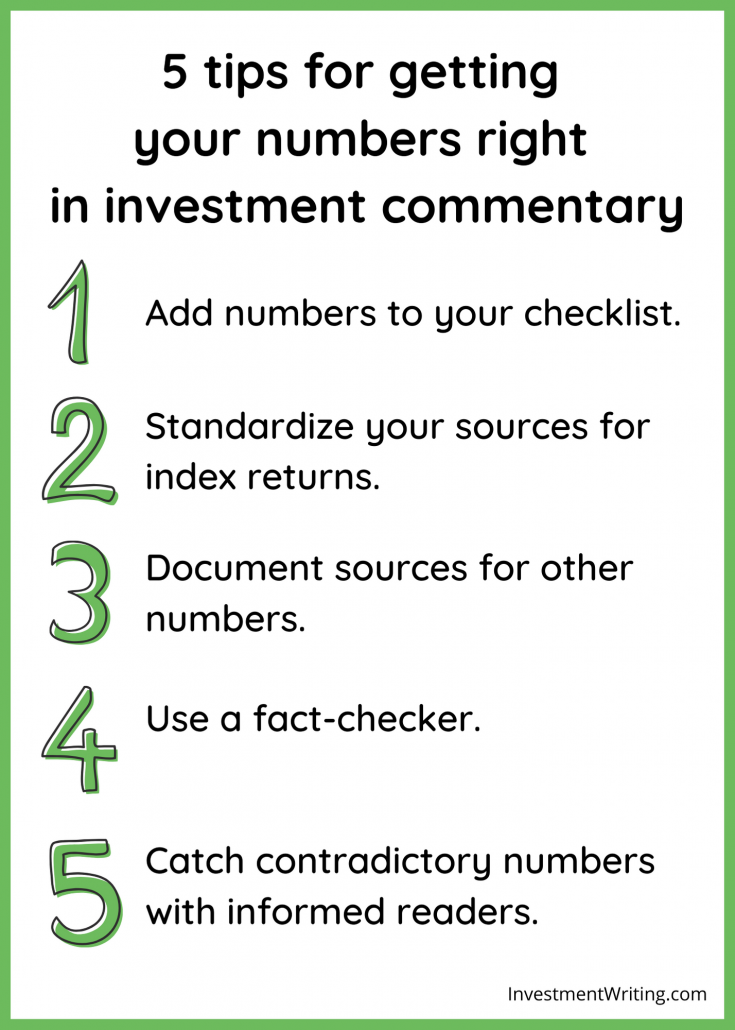Investment commentary numbers: How to get them right
Investment commentary calls for lots of numbers: benchmark and portfolio returns, economic data, and more. When you get those numbers wrong, you undercut your credibility and embarrass yourself.
I have some ideas about how you can avoid mistakes by proofreading and checking your facts.
My expensive mistake
A bad experience impressed me with the importance of checking numbers. Reading the professionally printed copy of my employer’s third-quarter commentary, I noticed a goof. It referred to the second quarter, instead of the third quarter, in one spot. This happened even though four of us had read the piece before it went to the printer. However, the eye tends to read what it expects to see. We all glossed over my error. Oops!
That was an expensive mistake because we had to get the piece reprinted. However, at least we avoided the embarrassment of clients seeing our mistake. Also, it spurred me to develop techniques for catching numerical errors.
Tip 1. Add numbers to your checklist
Checklists, which I recommend in “5 proofreading tips for quarterly investment reports,” can help you catch numerical errors. For a typical quarterly investment publication, I’d add two kinds of numerical items to remind you to check for accuracy and timeliness.
- Calendar information—record the current year, quarter, and ending date for the quarter. I don’t know about you but I sometimes can’t remember how many days there are in June so it’s handy to know that I should write about “the period ended June 30.”
- Major index returns for the relevant periods—if you’re writing about multiple investment styles and periods, you’ll use multiple index returns. If possible, run a report that shows only the relevant returns and displays them in a logical order. If you lack the access to run or customize reports, create your own list and proofread it carefully.
After you’ve completed your writing, make one pass through your document to check that you’ve used the right calendar information and returns.
Tip 2. Standardize your sources for index returns
If you’re new to writing about investments, you might think, “The S&P 500 Index return for the fourth quarter is the S&P 500 Index return for the fourth quarter.” Uh uh. There’s not just one number. For example, the return number that comes directly from Standard & Poor’s may diverge from the number spit out by your firm’s performance measurement system. Which will you use?
Your firm needs to decide which are the official sources for index returns. And then, stick with using those sources. By the way, it’s also good to create a rule for how many places to the right of the decimal point you’ll go in reporting returns.
You should create similar rules for reporting portfolio returns, too.
Tip 3. Document sources for other numbers
What about sources for other numbers? Document those as you write.
Footnotes can track your sources. Insert a footnote with your data source. Insert a link to the data if one is available. It’ll make fact-checking easier later on.
Tip 4. Use a fact-checker
Just as it’s hard for you to proofread your own work, it’s hard for you to fact-check it. You’ll tend to see what you expect to see.
If you have an employee, colleague, or friend who can help, ask that person to compare every number to its approved source. Being unfamiliar with numbers, they’re more likely to pick up on mistakes.
Don’t have a helper? Fact-checking will still catch some errors. I know it works for me, especially if I concentrate solely on fact-checking in one pass through my document.
Tip 5. Catch contradictory numbers with informed readers
How can you catch two authors using contradictory numbers? Say, for example, one author says U.S. economic growth was 2.2% while another says it was 2.5%. Both provide a source for their numbers, as suggested in Tip 3, but they don’t match. If you’re lucky, your fact checker will catch the disparity. But you can’t count on it.
There’s a higher chance of catching the error if you have the two authors with overlapping topics read each other’s articles. Ask them to look for inconsistencies. Another approach is to get a third party to look for inconsistencies. You might even ask them to list all of the document’s numbers from non-standardized sources. That would make it easier to see that there are multiple sources for a single number. All of this takes a lot of time.
There’s no easy way to catch these contradictory numbers. If you have ideas about how to solve this problem, I’d like to hear from you.
Image courtesy of Stuart Miles at FreeDigitalPhotos.net








Great point, and great suggestions.
Thank you, Theresa!
Susan–
These are all great suggestions! I have one more: DEVELOP A SIMPLE, CLEAR, AND STRAIGHTFORWARD APPROACH TO HOW YOU ORGANIZE AND LAY-OUT YOUR NUMBERS. It should be a style that is consistent and one that you are familiar and comfortable with.
This is really no different from making sure that your WRITING is correct and mistake-free: It’s much easier to proofread your sentences if they’re short, grammatically correct, and free of unnecessary flourishes. (Your recent blog about the “grade level” of your writing is a related question here.)
In other words, clear numbers presentation — like clear writing — is not just a good thing for your audience’s comprehension, it’s a good thing for you, too.
Thanks, Randall. I agree that layout of the numbers is important. You have some nice tips about that in your book.